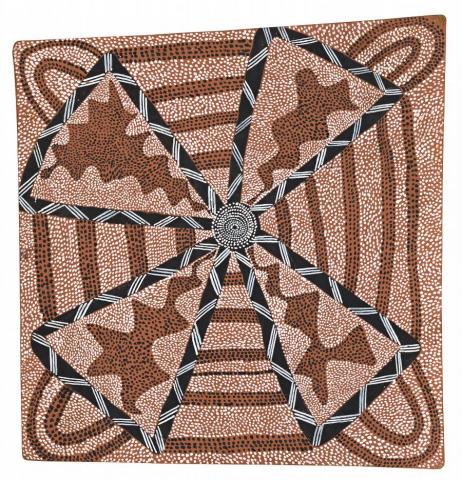UNTITLED, c.1972
Anatjari No. III Tjakamarra
synthetic polymer paint on composition board
54.0 x 49.0 cm (irregular)
inscribed verso: artist's name, date
A gift to the vendor from his brother, an aeronautical engineer who was employed in the 1980s at the satellite tracking station near Alice Springs. This work was acquired from a Telstra worker who had been previously employed in the Aboriginal communities in the 1970s and had acquired works at that time.
Private collection, Hong Kong
Myers, F.R., Painting Culture: The Making of an Aboriginal High Art, Duke University Press, Durham and London 2002, pp. 86– 106 for a detailed analysis of the artist's (refered to as Yantajari Tjakamarra) early paintings in relation to his exploration of the mythological/ritual Tingari cycle
One of the original group of painting men at Papunya in 1971-1972, Anatjari Tjakamara was born in southern Pintupi country and amongst the last of his people to leave the traditional homelands. Tjakamarra was a meticulous painter producing works of great precision and detail. From late 1972 to 1975, Anantjari was very active, his artistic output increased by his stimulating role in Tingari initiations and travels back to his homelands. The artist held custodial rights over sections of the Tingari Cycle mythology, particularly relating to areas around Kurlkurtanya and Kaakurutintjinya (Lake MacDonald), the Wati Kutjarra (Two Men mythology) and the Wayurta (Possum) dreaming that crossed paths with the Tingari.1
This painting on composition board, most likely completed in late 1972, relates to the artist's experimentation with combinations of circular and rectilinear shapes. This painting probably refers to the waterhole site of Pakarangaranya, part of the Wati Kutjara mythology. Constructed around a central roundel, the form anchors a rectilinear set of diagonal structures. The roundel is said to be the waterhole at Pakarangaranya where the two men camp. Frightened by mamu (demons), the two men stand up facing in opposite directions. Here they are turned to stone. The men are represented by the slightly triangular semicircles at the corners of the painting. The diagonal fields sweeping up to the corners represent gravelly areas of small rocks. By superimposing fields of small dots, Tjakamarra has indicated geographic sites.2
Curator Judith Ryan sees Pintupi depictions of the Tingari as ‘linear and cerebral. The graphic network of lines linking sites or resting places forms a condensed map of Pintupi country. Where masculine power is symbolised by the dynamic travelling principle and not by the stagnant lifestyle of large settlement.'3 The evolution of Anatjari Tjakamarra's painting seems to confirm this view as between 1973-1975 his experimentation and variation with representations of the Tingari was refined and reduced until his depictions became variations of large floating roundels and rectilinear shapes.
Tjakamarra relocated to Tjukurla in Western Australia in the early 1980s were he took an extended break from painting. In the late 1980s he moved to Kiwirrkura and subsequently returned to painting for Papunya Tula Artists. In 1989 he had a solo exhibition in New York from which the Metropolitan Museum of Art purchased a painting, representing the first time a work of art by an Australian Aboriginal artist had been acquired for its collection.
1. Myers, F.R., Painting Culture: The Making of an Aboriginal High Art, Duke University Press, Durham and London, 2002, p. 86
2. Ibid. p. 94
3. Ryan, J., 'The Mythology of Pattern; Papunya Tula Art 1971-1989', in Mythscapes; Aboriginal Art of the Desert from the National Gallery of Victoria, National Gallery of Victoria, Melbourne, 1990, p. 29
